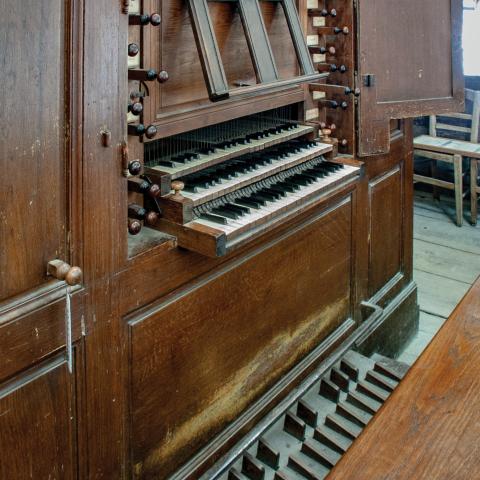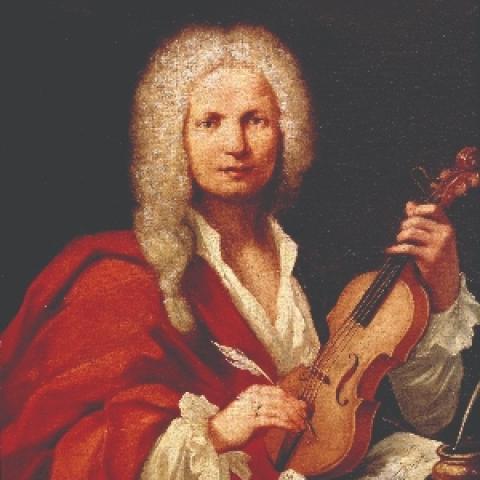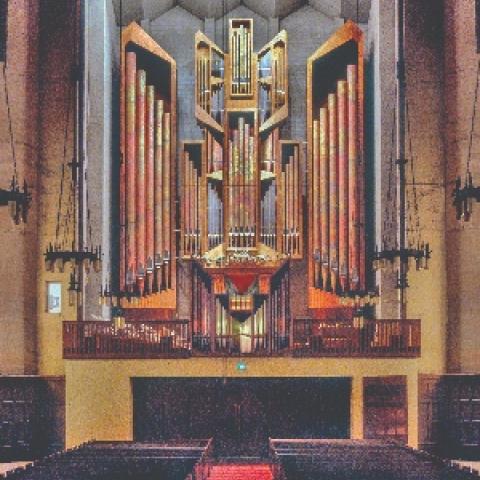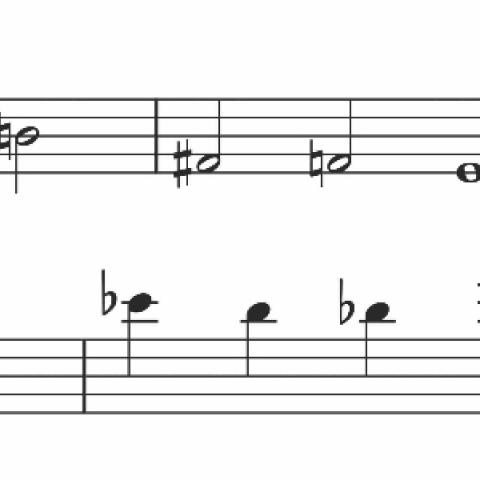Michael McNeil has designed, constructed, voiced, and researched pipe organs since 1973. Stimulating work as a research engineer in magnetic recording paid the bills. He is working on his Opus 5, which explores how an understanding of the human sensitivity to the changes in sound can be used to increase emotional impact. Opus 5 includes double expression, a controllable wind dynamic, chorus phase shifting, and meantone. Stay tuned.
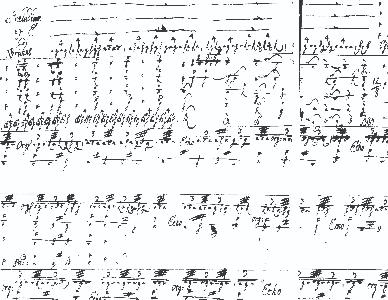
Many of the organ compositions of Dieterich Buxtehude (c. 1637–1707) and Nicolaus Bruhns (1665–1697) contain bass accidentals that are not playable on the short-octave manual and pedal basses of the late-seventeenth-century organs of Lübeck. The bass octave of Buxtehude’s organs contained just eight notes—C, D, E, F, G, A, A-sharp, and B—a consequence of meantone tuning. It is impossible to imagine that these wonderful and dramatic compositions were not played in some manner on those organs, but that is the extraordinary claim of at least one modern researcher.1
A solution to this problem might lie in its history. The original scores of the organ works of Buxtehude and Bruhns were written in tablature, an older form of notation that looks nothing like modern notation. Figure 1 shows an example of tablature and modern notation for the same composition. And here is the key point: none of the tablature originals have survived. All extant versions in tablature are copies, and copies often contain errors. Our modern scores are transcriptions from tablature to modern notation. Transcriptions may contain errors, not the least of which is that the intended octave in tablature is often ambiguous.2, 3, 4 Figure 2 shows an example of a tablature copy of Bruhns’s Praeludium in E Minor (the smaller of the two E minor praeludia).
What might have motivated eighteenth- and nineteenth-century musicians to modify the original tablature manuscripts to be unplayable on the organs for which they were composed? The musicians who later copied or transcribed the originals were familiar with later organs that had full-compass basses, or perhaps only a missing low C-sharp. We should also note that the later shift toward equal temperament eliminated the intense gravity of meantone’s pure major thirds, whose resultants sound a full two octaves lower in pitch. The disappearance of this gravity may have influenced the desire to shift tenor accidentals and the phrases in which they were embedded to the bass octave. The ambiguity of the intended octave in tablature may have also provided the rationalization to do so. Equal temperament’s loss of gravity was a strong motivation for eighteenth-century organ builders to include deeper and very costly pitches in their stoplists.5
Meantone, unlike equal temperament, has intense key color. Modern-received wisdom relates that the strong dissonances in meantone were avoided in practice; history teaches us otherwise. Dom Bédos argued that meantone was more musical than equal temperament because it presented the composer with useful tensions between the purity of its eight major thirds and the dissonance of its four Pythagorean thirds. Bédos was explicitly referring to quarter-comma meantone.6 Restoring bass accidentals to the tenor heightens their dissonance (beat rates will double), setting up tension for later resolution with meantone’s pure thirds.
The short bass octave is an essential feature of the great meantone organs of Lübeck on which the compositions of Buxtehude and Bruhns were most logically composed and played. The short octave with its four missing accidentals has an unusual key order:
D E A#
C F G A B
This indicates the use of an original form of meantone, i.e., quarter-syntonic comma, not the later and much less colorful versions like Gottfried Silbermann’s fifth-comma meantone. Dissonances were used to good effect, but dissonances in quarter-comma meantone also supported the elimination of accidental bass pipes, saving space in their layouts and considerable cost. Later versions of meantone in the eighteenth century reduced both the dissonances and the purity of meantone; this supported the use of more accidentals in the bass of new organs, often omitting only the C-sharp in a normal order of the bass keys:
D# F# G# A#
C D E F G A B
We know that the organ compositions of Buxtehude and Bruhns were composed when the large organs of Lübeck had short bass octaves, and there is evidence that those organs were not retuned from their original meantone in Buxtehude’s time.7 This suggests that the presence of any bass accidentals other than A-sharp in the organ works of Buxtehude and Bruhns very likely denotes deliberate changes in modern transcriptions to accommodate later organs with more complete bass octaves and much less colorful temperaments.
We will never know if any of our reconstructions are faithful to the originals—they are all lost. But we can use our knowledge of meantone’s inherent dissonant tension and majestic purity to aim for a reconstruction that heightens the emotional impact of these compositions. This is completely in character with the stylus phantasticus, a term coined for the freely composed organ works of Buxtehude and Bruhns—works that speak to modern ears with emotional intensity and dramatic rhythms. These works perfectly express the unique sound of a pipe organ’s principal chorus and thundering pedal bass. And unlike modern compositions, these works feature the musicality and gravity of seventeenth-century meantone.
I am an organbuilder, not a musician skilled in composition. I built my Opus 5 for, among other things, the purpose of showcasing the effect of quarter-comma meantone on the works of Buxtehude and Bruhns, only to discover that many of the modern scores are deeply flawed. Finding no one willing to address this problem, I have evaluated and restored the following scores:
Dieterich Buxtehude: Praeludium in C Major, BuxWV 137, restored; Toccata in D Minor, BuxWV 155, restored; Toccata in F Major, BuxWV 157, no issues; Ciaccona in E Minor, BuxWV 160, no issues; Fuga in C Major, BuxWV 174, no issues;
Nicolaus Bruhns: Praeludium in E Minor (“Little”), restored.
At the end of this article you will find my suggested corrections, all of which are in the pedal, noting the editions I used. If a reader objects that others are much more qualified to make these corrections, I could not agree with you more, and I wholeheartedly welcome those with more skill to propose solutions that are playable on historically correct, short-octave organs.
We can debate how much of a phrase containing bass accidentals needs to be moved to the tenor. We can debate whether the bass accidentals are themselves errors that represent different notes. But if we accept that Buxtehude and Bruhns created their compositions on the organs of their time, we must also accept that the accidentals C-sharp, D-sharp, F-sharp, and G-sharp in the bass octaves of modern scores are not faithful to the original compositions.
Claiming that these compositions were not meant to be played on the large and grand late-seventeenth-century organs of Lübeck is analogous to saying that the Scherer family and Friedrich Stellwagen made and maintained beautiful organs with wonderful sounds, but those short-octave organs were not meant to be played—they were just exercises in thought.
Notes
1. Ibo Ortgies, Die Praxis der Orgelstimmung in Norddeutschland im 17. und 18. Jahrhundert und ihr Verhältnis zur zeitgenössischen Musik, Göteborgs universitet, 2007, page 2, Abstract: “An analysis of payments to bellows pumpers as recorded in church account books shows that the organs of St. Marien, Lübeck, were not retuned during the tenures of Franz Tunder and Dieterich Buxtehude. Thus, some of their organ works could not have been played on the organs available to them during their lifetimes.” [translated by John Brombaugh]
2. organscore.com/buxtehude-complete-organ-works, accessed June 2022. “Editing Buxtehude’s organ work is a delicate task because we do not have access to any holographic source of these works. The available manuscripts are all copies by eighteenth- and nineteenth-century organists, mostly written in modern notation system—the originals were probably in German organ tablature—and contain transcription errors such as missing notes, confused voices, incorrect note heights or accidentals, and poorly placed bars. In places where the music is obviously corrupted and no complementary source is available, the editor must reconstruct the music by guessing at the original idea. Because of this, no modern edition can claim to be the genuine composer’s text.”
3. en.opera-scores.com/O/Dieterich+Buxtehude/Herr%2C+ich+lasse+dich+nicht%2C+BuxWV+36.html, accessed June 2022. “Copies made by various composers are the only extant sources for the organ works: chorale settings are mostly transmitted in copies by Johann Gottfried Walther, while Gottfried Lindemann’s and others’ copies concentrate on free works. Johann Christoph Bach’s manuscript is particularly important, as it includes the three known ostinato works and the famous Praeludium in C Major, BuxWV
137. Although Buxtehude himself most probably wrote in organ tablature, the majority of the copies are in standard staff notation.
“The nineteen organ praeludia form the core of Buxtehude’s work and are ultimately considered his most important contributions to the music literature of the seventeenth century. They are sectional compositions that alternate between free improvisation and strict counterpoint. They are usually either fugues or pieces written in fugal manner; all make heavy use of pedal and are idiomatic to the organ. These preludes, together with pieces by Nicolaus Bruhns, represent the highest point in the evolution of the north German organ prelude and the so-called stylus phantasticus. They were undoubtedly among the influences on J. S.
Bach, whose organ preludes, toccatas, and fugues frequently employ similar techniques.
“Occasionally the introduction will engage in parallel thirds, sixths, etc. For example, BuxWV 149 begins with a single voice, proceeds to parallel counterpoint for nine bars, and then segues into the kind of texture described above. . . . [Note the reference to writing in parallel thirds and sixths. This works extremely well with meantone’s pure thirds. All of equal temperament’s major thirds are very, and equally, dissonant.]
“Buxtehude’s other pieces that employ free writing or sectional structure include works titled toccata, praeambulum, etc. A well-known piece is BuxWV 146, in the rare key of F-sharp minor; it is believed that this prelude was written by Buxtehude especially for himself and his organ, and that he had his own way of tuning the instrument to allow for the tonality rarely used because of meantone temperament.” [The key of F-sharp minor in Pietro Aron’s quarter-comma meantone, with the wolf placed on the interval G-sharp to D-sharp, is very useful; its minor third is much less dissonant than an equal temperament minor third. Furthermore, the minor third beats at exactly twice the rate of the fifth. This is a sonorous key in meantone. (See the beat rate chart on page 131 in The Sound of Pipe Organs, Michael McNeil, 2012.) As there were no pedal F-sharp bass keys on Buxtehude’s organs, this note would have been played in the tenor.]
4. en.wikipedia.org/wiki/Organ_tablature, accessed June 2022. “. . . The feature of organ tablature that distinguishes it from modern musical notation is the absence of staves, noteheads, and key signatures. Pitches are denoted by letter names written in script, durations by flags (much like modern notation), although in early notations durations were shown using mensural indications, and octave displacement by octave lines drawn above a letter. There was some variation in the notation of accidentals, but sometimes sharps were specified by the addition of a loop to the end of the letter. B-natural and B-flat were represented by h and b respectively. Naturals are not indicated, as accidentals do not carry through the entire measure as in modern notation. Key signatures are not specified; they are implied by the indicated sharps.
“. . . Repertoire originally written in tablature has been translated into modern notation. However, this translation carries a risk of error. In German script an A and an E can become confused, as can an F and a G. Likewise, an octave line over a series of notes can begin or end ambiguously. Different solutions are given by different editors, and this is one manifestation of the improvisatory tradition of organ performance of the period.”
6. John Brombaugh analyzed Bédos’s tables of meantone intervals, and McNeil found the result was virtually identical to Pietro Aron’s equal-beating quarter-syntonic-comma meantone (see Owen Jorgensen, Tuning the Historical Temperaments by Ear, Northern Michigan University Press, 1977, pages 173–177).
7. Ibo Ortgies. See quotation in Note 1.
Restorations for performance on meantone organs with short bass octaves, C, D, E, F, G, A, A-sharp, and B
All examples are in the bass clef in the pedal.
Edition Peters 4855, Nicolaus Bruhns, 1968
Nr. 3, Praeludium und Fuge e-moll (“Little”), pages 20–24. See Examples 1 and 2.
Edition Renaud Vergnet, D. Buxtehude, Volume 1, 2018
Praeludium in C Major, BuxWV 137, pages 5–7. See Examples 3 through 16.
Edition Renaud Vergnet, D. Buxtehude, Volume 2, 2018
Toccata in D Minor, BuxWV 155, pages 2–5. See Examples 17
through 19.

